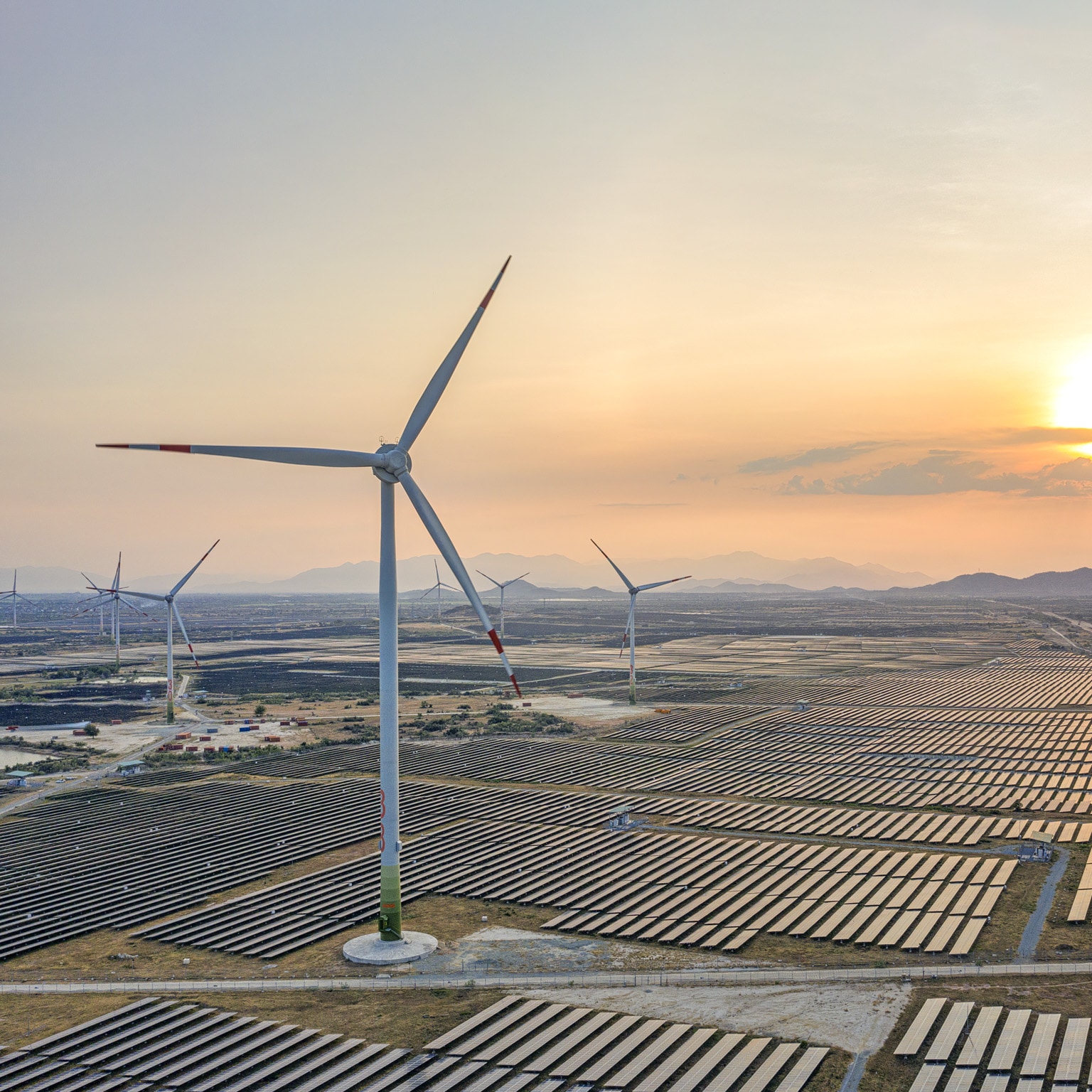Renewable energy is becoming a critical component of the energy landscape in Southeast Asia. Driven by sustainability goals and the urgent need to reduce carbon emissions, the region has witnessed remarkable growth in this sector.1 Going forward, solar photovoltaic (PV) is projected to become more widespread in Southeast Asia and to more than double between 2022 and 2030—from around 25 gigawatts (GW) in 2022, to potentially beyond 100 GW in a net-zero scenario.2
Southeast Asia has ample solar resources and has committed to harness them in the quest to reduce emissions.3 As solar PV technology advances and costs continue to decline, the region is well-placed to make it the cornerstone of its transition to renewable energy.
Up to now, solar PV growth in Indonesia has been slow compared to various other countries in the region and, to overcome this, Indonesia’s government has set targets to increase solar PV substantially by 2030.4 The sector, though, will face challenges in producing solar products that can compete with those of other exporting nations. It is likely that there will not be sufficient domestic demand to scale production to a level high enough to reduce average costs and allow Indonesia to be competitive in the region.
However, Singapore’s Energy Market Authority’s (EMA) plan to import renewable energy presents a good opportunity for Indonesia. This will provide significant potential demand on which Indonesia could capitalize to scale its solar PV production. Indonesia could also learn valuable lessons from the trajectories of some of its regional peers that have successfully gained traction in the market.
Still, this scale up might not be enough to allow Indonesia to compete regionally. In this case, the country could look to methods designed to attract foreign OEM investments and follow the examples of neighboring countries that have relaxed local content requirements to scale up solar manufacturing.
Solar PV: Growing slower in Indonesia than in some of its regional peer nations
Indonesia, Thailand, and Vietnam lead the renewables scene in Southeast Asia, with around 13 GW, 12 GW, and 45 GW of installed capacity, respectively.5 Hydroelectric power is the dominant generation method, contributing around more than 60 percent of total renewable capacity in 2022. Solar and wind are the next biggest renewable generation methods, contributing approximately 30 percent and 7 to 8 percent to renewable capacity, respectively. (Exhibit 1).

Solar PV has not scaled as fast in Indonesia as in some of its regional peers. In 2022, the country had 0.3 GW of installed capacity—low compared to the 3.1 GW and 18.5 GW of Thailand and Vietnam, respectively (Exhibit 2).

The sluggish growth can be attributed to various causes: first, as the country consists of over 17,000 islands, Indonesia’s geography is challenging for any infrastructural project. Second, the country has enjoyed an oversupply of coal and gas from Java, which has stunted growth elsewhere in the country.6 Third, solar is frequently outcompeted by local, low-cost alternatives such as coal.7 And, finally, Indonesia’s import taxes have created higher costs compared to its peers in rolling out solar PV.8
However, solar PV is expected to grow significantly. Indonesia’s electricity capacity is planned centrally, directed by its long-term Electricity Business Plan (RUPTL).9 According to the plan, solar PV is set to contribute around 5 GW by 2030.
Meeting this commitment requires Indonesia to build approximately 0.7 gigawatt peak (GWp) of solar PV power plants a year, presenting opportunities across the solar PV value chain.10 By establishing domestic solar PV manufacturing facilities, Indonesia could avoid relying on imported solar products, boost job creation, and foster technological innovation.
Indonesia’s RUPTL also contains a 40 percent mandatory local content requirement (called TKDN) on components in the solar PV value chain, which was applied in 2022 (Exhibit 3). By 2025, the TKDN is set to increase to up to 90 percent—a major concern for OEMs looking to invest in Indonesia. Negotiations with the Indonesian government may be required to secure proper syndication in the value chain and assure OEMs of their investments.

In a further effort to encourage the local manufacturing industry, the Indonesian government has recently banned the export of quartz sand and silica sand (key components in solar PV modules).11
At the same time, the Indonesian government is already considering relaxing the TKDN content to enable local manufacturing to be established in the next few years.12
Would you like to learn more about McKinsey Sustainability?
Singapore’s EMA: A significant opportunity for export-led demand in Indonesia
Singapore’s EMA sets out the country’s plan to import a baseload of up to 4 GW alternating current (GWac) of low-carbon electricity a year by 2035.13 Through this, Singapore aims to create cross-border electricity trade, enhance energy reliance, and promote clean and renewable energy integration in the ASEAN region. This presents Indonesia with a clear—and pressing—opportunity to grow its solar PV infrastructure to supply clean, solar-derived energy to Singapore (Exhibit 4).

From November 2021 to April 2022, the EMA launched its first request for proposal (RFP) for the import of up to 1.2 GW, set to begin by 2027. A second RFP for the remaining capacity was launched in July 2022 and is due by December 2023.14
With a typical capacity factor (CF) of around 16 percent, the remaining capacity for the second RFP (roughly 2.8 GWac) would require around 17.1 GWp installed capacity in solar PV power plants. These requirements present further opportunities for Indonesia to benefit from scaling up its solar PV manufacturing capabilities.
Challenges on Indonesia’s path to solar growth
There are various stumbling blocks, however. One of the biggest challenges is how to compete with the cost of products from China. The cost of solar production declines significantly with the volume produced and, to be competitive, Indonesian manufacturers would need to meet a minimum of around 3 GWp to 7 GWp per year to bring production costs down to around $0.24 per Wp (Exhibit 5).

Supplying Singapore with 2.0 GWac (or roughly 12.0 GWp of solar power plants) would add around 1.7 GWp to Indonesia’s annual capacity demand until 2030. Combined with the demand related to the RUPTL target of around 0.7 GWp a year, the total projected demand comes to around 2.4 GWp a year—still below the minimum production capacity needed to be cost-competitive (Exhibit 6).

Another challenge arises geographically: solar potential in Indonesia is greater in the eastern region than in the western. This leaves the country’s greatest solar concentration at its furthest point from Singapore and in regions where electricity demand is lowest (Exhibit 7). Indonesia will need to factor this in when selecting locations for manufacturing facilities.

Trends in solar PV in Southeast Asia: Models for growth
As of 2023, China dominates the entire PV manufacturing chain—filling the world’s capacity for solar polysilicon, ingot and wafer, solar cell, and solar module at 79 percent, 95 percent, 76 percent, and 68 percent, respectively. However, domestic manufacturing of solar PV components is an increasingly common trend in the ASEAN region, including in India and Vietnam, and Indonesia could potentially join its neighboring countries in such production. (Exhibit 8).15

India: Incentivizing domestic manufacturing
India is a showcase example of successful growth in solar PV. In March 2023, the Indian government auctioned for and was awarded 39.6 GW of solar manufacturing to 11 companies. The government encouraged manufacturing with the second phase of its Production Led Incentive (PLI), offering INR 140 billion (around $1.7 billion) in subsidies to be released over five years from the start of production.16
These subsidies have allowed domestic PV manufacturers to bring down operating costs enough to be competitive with products from China, achieving a cost of around $0.20 to $0.21 per Wp.17 In tandem, the Indian government imposed a 40 percent tariff on products imported from China, increasing the price from roughly $0.17 to $0.24 per Wp.18

Putting renewable energy within reach: Vietnam’s high-stakes pivot
Vietnam: Attracting overseas investment
Vietnam, in contrast, has opted to impose no local content obligation on its solar PV manufacturing industry. Instead, the government has introduced tax incentives to attract investments from overseas OEMs. These factors, combined with low costs and Vietnam’s proximity to China, have succeeded in attracting Chinese OEMs to move some of their production to Vietnam. Chinese OEMs are motivated to do this partly because they do not have to pay the tariffs that are imposed by other countries on Chinese solar PV products.19
Vietnam has also boosted its solar energy production by introducing a high feed-in tariff (FiT), offering energy producers a rate of $84/MWh in 2019, well above the estimated levelized cost of electricity (LCOE) of solar power plants ($68/MWh).20 The FiT has successfully enhanced domestic demand for solar PV products.
The Vietnamese example may contain lessons of particular relevance to Indonesia. Unlike India, Vietnam does not have a large enough domestic market to allow for a solar manufacturing industry that will sell entirely locally. Therefore, Vietnam has attracted investment from Chinese OEMs that have targeted module assembly in Vietnamese plants—the simplest and lowest-risk stage of the value chain.
Indonesia’s small-scale manufacturing industry, combined with the risk that it may not generate enough demand to be regionally cost-competitive, suggests that it may benefit from imitating some aspects of the Vietnamese model.
Boosting large-scale solar PV manufacturing in Indonesia
Indonesia could capitalize on increasing domestic and regional demand by scaling up solar PV manufacturing. However, the country may need to address the following issues to attain success.
Incentivizing investments
One of the primary requirements in building a robust solar PV manufacturing sector is attracting substantial investments. To achieve this, Indonesia may consider incentives to entice foreign and domestic investors. These could include:
- Grants for plant development. Providing financial grants or subsidies for the development of solar PV manufacturing plants could significantly reduce upfront costs for investors, making the sector more attractive and accelerating growth.
- Low-cost credit. Offering access to low-cost credit facilities could alleviate the financial burden on manufacturers and facilitate the establishment of production facilities on a larger scale.
- Electricity subsidies. Implementing subsidies or preferential electricity pricing for solar PV manufacturers could help offset operational costs and ensure competitiveness in the market.
- Flexibility around local content requirements. Offering flexibility around local content requirements could attract foreign OEMs, encouraging them to invest in Indonesia’s solar PV manufacturing sector. This would facilitate the transfer of technological knowledge and contribute to the development of the sector.
Stimulating additional local demand
To foster a vibrant solar PV manufacturing ecosystem, Indonesia could explore paths to increase domestic demand for solar products. One viable approach is to focus on the rapidly growing battery manufacturing sector by providing incentives for operators to produce batteries for storing renewable energy. By doing so, the country could facilitate the synergy of the solar PV and energy storage sectors, driving growth in a domestic sustainable market.
Alternatively, the Indonesian government could mandate the adoption of solar PV systems in every new battery plant. This top-down approach could boost demand for solar PV products significantly and create an environment favorable to manufacturing investments.
Exploring export opportunities
Indonesia could also explore opportunities for export to meet the minimum demand for cost-competitive solar PV manufacturing. However, certain markets—such as Europe—may already be saturated with operators that provide more than 10 GW a year, making entry to these markets difficult.21 Nevertheless, strategic partnerships and collaboration with countries that have less stringent local content regulations may help Indonesia tap into new markets, boosting it toward achieving a competitive solar PV industry.
Indonesia’s government aims to ramp up its solar PV manufacturing industry significantly. This could help the country meet its domestic renewables’ targets and compete in regional solar power supply. But domestic demand, even when combined with the potential rewards presented by Singapore’s EMA’s plan to import low-carbon electricity, may not be enough to grow Indonesia’s solar industry to be cost-competitive regionally.
Indonesia could learn from the success of regional peers, India and Vietnam, in achieving a competitive scale in their solar industries. By applying similar steps—like incentivizing investments, providing flexibility in local content requirements, stimulating local demand, and exploring export opportunities—Indonesia could establish a thriving solar PV manufacturing sector.

